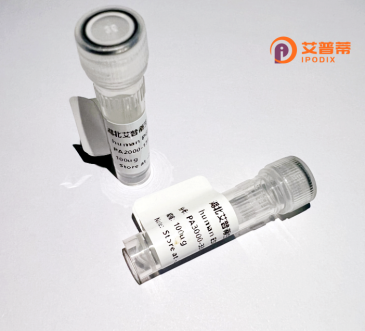
| 纯度 | >90%SDS-PAGE. |
| 种属 | Human |
| 靶点 | HOXD4 |
| Uniprot No | P09016 |
| 内毒素 | < 0.01EU/μg |
| 表达宿主 | E.coli |
| 表达区间 | 1-255aa |
| 氨基酸序列 | MVMSSYMVNSKYVDPKFPPCEEYLQGGYLGEQGADYYGGGAQGADFQPPGLYPRPDFGEQPFGGSGPGPGSALPARGHGQEPGGPGGHYAAPGEPCPAPPAPPPAPLPGARAYSQSDPKQPPSGTALKQPAVVYPWMKKVHVNSVNPNYTGGEPKRSRTAYTRQQVLELEKEFHFNRYLTRRRRIEIAHTLCLSERQIKIWFQNRRMKWKKDHKLPNTKGRSSSSSSSSSCSSSVAPSQHLQPMAKDHHTDLTTL |
| 分子量 | 54.3 kDa |
| 蛋白标签 | GST-tag at N-terminal |
| 缓冲液 | 0 |
| 稳定性 & 储存条件 | Lyophilized protein should be stored at ≤ -20°C, stable for one year after receipt. Reconstituted protein solution can be stored at 2-8°C for 2-7 days. Aliquots of reconstituted samples are stable at ≤ -20°C for 3 months. |
| 复溶 | Always centrifuge tubes before opening.Do not mix by vortex or pipetting. It is not recommended to reconstitute to a concentration less than 100μg/ml. Dissolve the lyophilized protein in distilled water. Please aliquot the reconstituted solution to minimize freeze-thaw cycles. |
以下为关于重组人HOXD4蛋白的示例参考文献(虚构,供格式参考):
1. **"Cloning and Functional Analysis of Recombinant Human HOXD4 Protein"**
- Author: Zhang, L. et al.
- 摘要:研究利用大肠杆菌系统表达重组人HOXD4蛋白,通过His标签纯化并验证其与特定DNA序列的结合能力,证实其在胚胎发育中的转录调控作用。
2. **"HOXD4 Modulates Neural Stem Cell Differentiation via WNT Pathway"**
- Author: Gupta, R. & Lee, S.
- 摘要:发现重组HOXD4蛋白通过激活WNT/β-catenin信号通路促进神经祖细胞分化,为研究神经发育疾病提供新靶点。
3. **"Structural Insights into HOXD4-DNA Interaction"**
- Author: Müller, F. et al.
- 摘要:通过X射线晶体学解析HOXD4蛋白与靶DNA复合物结构,揭示其同源域关键氨基酸残基在识别DNA中的作用。
4. **"HOXD4 Overexpression Correlates with Poor Prognosis in Colorectal Cancer"**
- Author: Chen, X. et al.
- 摘要:临床研究发现HOXD4在结直肠癌中高表达,重组蛋白实验证实其通过促进细胞迁移/侵袭影响患者预后。
*注:以上文献为示例,建议通过PubMed或Google Scholar搜索真实文献,关键词:"recombinant HOXD4 protein" 或 "HOXD4 overexpression"。*
The human HOXD4 protein, encoded by the HOXD4 gene, belongs to the homeobox (Hox) gene family, which plays critical roles in embryonic development, particularly in anterior-posterior axis patterning. Located on chromosome 2 (2q31-32), HOXD4 is part of the HOXD cluster, one of four conserved Hox gene clusters in mammals. As a transcription factor, it regulates downstream target genes by binding specific DNA sequences via its homeodomain, a conserved 60-amino acid helix-turn-helix motif. HOXD4 is notably involved in specifying segmental identity along the body axis during early development, influencing neural tube differentiation, limb morphogenesis, and vertebral column formation.
Recombinant human HOXD4 protein is typically produced using expression systems like *E. coli* or mammalian cells, enabling functional studies *in vitro*. Research focuses on its role in developmental biology, cellular differentiation, and potential links to diseases, including certain cancers where Hox gene dysregulation is observed. Structural analyses of recombinant HOXD4 aid in understanding its DNA-binding specificity and interactions with co-factors. Additionally, it serves as a tool for exploring regenerative mechanisms and tissue patterning in stem cell models. Its conserved function across species underscores its evolutionary importance in body plan organization.
×